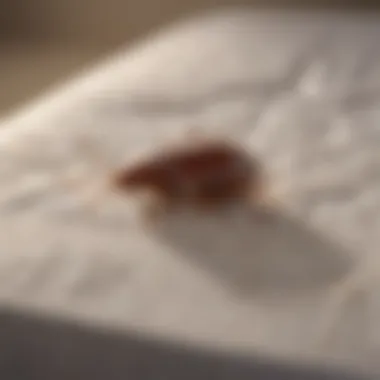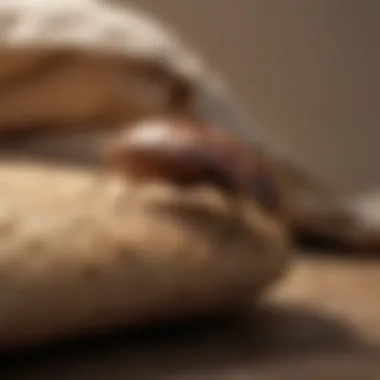Are Bed Bugs Attracted to Food? Unveiling Myths and Facts


Intro
Bed bugs, despite their name, are not typically associated with food in the same way people might think. Their primary sustenance comes from the blood of humans and animals. This article aims to dissect the common myths surrounding bed bugs and their dietary habits. It seeks to provide clarity on whether these pests are really attracted to food items found in our homes.
By examining their biological needs and behavior, homeowners and pest control professionals can better understand how to manage infestations effectively. This knowledge forms the basis for better prevention and treatment strategies.
Pest Identification
To manage any pest issue, the first step is to correctly identify the pest. Bed bugs, scientifically known as Cimex lectularius, are small, oval, brownish insects. They are about the size of an apple seed and have a flat body when unfed, which allows them to hide easily in crevices.
Detailed Descriptions of Common Pests
While bed bugs are the focus here, it is useful to recognize similar pests that could confuse identification:
- Fleas: Small and agile, fleas hop and are primarily external parasites of animals.
- Ticks: These also feed on blood but are not as easily found indoors.
- Cockroaches: Larger and more visible, cockroaches may be mistaken for bed bugs due to size similarities in young instars.
Signs and Symptoms of Infestations
Identifying an infestation requires knowledge of certain signs:
- Bite Marks: Itching welts on skin commonly appear in clusters or lines.
- Fecal Spots: Tiny dark spots on bedding or surfaces are indicative of bed bug droppings.
- Shed Skins: As bed bugs mature, they shed their exoskeletons, which can be found in hiding spots.
- Musty Odor: A stale scent may emanate from heavily infested areas, linked to pheromones produced by bed bugs.
Understanding these signs can alert homeowners to the presence of bed bugs before the problem escalates.
Prevention Strategies
Preventing a bed bug infestation involves proactive measures within the household. Simple changes and habits can substantially reduce the risk of an infestation.
Home Maintenance Tips for Pest Prevention
- Regular Cleaning: Frequent vacuuming along baseboards, under the bed, and furniture can eliminate hidden bed bugs.
- Seal Cracks and Crevices: Caulking gaps around windows and doors will block potential entry points.
- Be Cautious with Used Furniture: Inspect second-hand furniture for signs of infestation before bringing it inside.
- Laundry: Washing bedding and clothing in hot water regularly can kill any hidden bed bugs.
Natural Deterrents and Barriers
Certain effective natural repellents can assist in deterring bed bugs:
- Diatomaceous Earth: A powder that disrupts the exoskeleton of bed bugs when they pass through it.
- Essential Oils: Scents like lavender or tea tree oil may help repel these pests, although they are not a complete solution.
While these measures can help, an understanding of their limitations is crucial.
Treatment Options
When prevention is unsuccessful and infestations occur, various treatment options can be utilized. The choice usually hinges on the severity of the infestation and the specific needs of the household.
Overview of Chemical vs. Natural Treatments
- Chemical Treatments: Professional pesticides can effectively eliminate bed bugs but may pose health risks if not used correctly.
- Natural Treatments: These are generally safer for families and pets but often less effective alone for severe infestations.
Step-by-Step Guides for DIY Treatments
- Identify Infested Areas: Thoroughly check for signs of bed bugs in the area.
- Isolate the Bed: Move the bed away from walls and use bed bug interceptors to trap bugs that may fall.
- Use Heat: Wash and heat-dry infested items on high for at least 30 minutes to kill bugs in all life's stages.
- Apply Diatomaceous Earth: Lightly dust areas where bed bugs might hide, paying close attention to high activity locations.
"A bed bug infestation can be daunting, but understanding its habits and prevention strategies empowers homeowners to take control."
This structured approach helps homeowners and pest control professionals confidently address the issue. It promotes responsible pest management without jumping to preconceived notions about bed bugs being attracted to general food items.
Preamble to Bed Bugs
Understanding bed bugs is vital for anyone dealing with infestations or concerned about these pests. This segment offers crucial insights into their nature and significance, setting the stage for later discussions about their dietary habits and how those habits interact with human environments.
Bed bugs, scientifically known as Cimex lectularius, are small, reddish-brown insects known for their appetite for blood, primarily from humans. Their elusive presence and ability to thrive in domestic settings make them a particularly pressing issue for homeowners. Comprehending their behaviors and life cycles helps equip individuals with the knowledge needed to identify and contend with potential infestations.
Furthermore, a deep dive into these pests lays the groundwork for comprehending their dietary preferences, particularly if they have any interest in various food items commonly found in homes. Knowing why and how bed bugs seek out hosts influences not only pest management strategies but also daily routines in affected households. Additionally, understanding the biology and behavior of bed bugs can reveal effective prevention methods that homeowners can adopt to minimize risks.
Whether you are currently facing an infestation or are simply curious about these resilient pests, this section provides essential information to aid in your understanding of bed bugs and their impact on human living spaces.


Defining Bed Bugs
Bed bugs are small, wingless insects that belong to the family Cimicidae. They are roughly the size of an apple seed, making them difficult to detect. Adult bed bugs measure about 4 to 5 mm in length and have a flattened body shape. Their coloration ranges from whitish to deep brown, depending on whether they have recently fed.
These nocturnal creatures primarily feed on the blood of mammals, particularly humans. Unlike other parasites, bed bugs do not inhabit only one host but will travel to multiple locations in search of food.
Life Cycle of Bed Bugs
The life cycle of bed bugs includes several stages: egg, nymph, and adult. The female bed bug can lay up to five eggs per day, which are tiny and white in color. Nymphs hatch from the eggs after about a week and progressively molt through five immature stages before reaching adulthood. The entire lifecycle can be completed in as little as five weeks under optimal conditions, depending on temperature and food availability.
"Understanding the life cycle of bed bugs is crucial for effective pest control strategies. If one stage is overlooked, it can lead to a widespread infestation."
Understanding Bed Bug Behavior
Understanding the behavior of bed bugs is crucial for several reasons. First, it helps to demystify their existence and elucidates their habits, which is vital for effective pest control. Not only does this knowledge equip homeowners with the necessary insights to address infestations, but it also dispels common myths surrounding bed bugs. This topic centers on two specific areas: their feeding mechanisms and their social behavior.
Feeding Mechanisms
Bed bugs possess a unique feeding mechanism that primarily involves biting hosts to obtain blood. Their mouthparts are specialized for piercing skin, making it easier to extract blood from human hosts, which is their primary nutritional source. These insects are nocturnal, meaning they are most active at night, taking advantage of their hosts' typically dominant sleeping hours. When a bed bug bites, it injects saliva into the host's bloodstream. This saliva contains anticoagulants that prevent blood clotting, allowing the insect to feed more efficiently.
Important Note: While bed bugs feed only on blood, this characteristic leads to a widespread misconception that they are attracted to food items found in kitchens or dining areas. In reality, bed bugs do not consume traditional food sources.
One significant aspect of their feeding behavior is the ability to sense heat and carbon dioxide, both of which are emitted by humans. This ability aids them in locating their hosts effectively. Feeding sessions can last anywhere from five to ten minutes, after which they retreat to hidden areas to digest their meal. Understanding these feeding mechanisms is essential as it informs strategies for prevention and management of bed bugs.
Social Behavior and Aggregation
Bed bugs exhibit notable social behavior, particularly in terms of aggregation. They tend to gather in groups, often hiding in crevices, mattress seams, and other secluded areas. This behavior is primarily a survival strategy, allowing them to share resources and remain close to potential hosts. The aggregation behavior also makes locating and eradicating them more challenging.
When one individual feeds, pheromones are released, signaling other bed bugs to join nearby. This can create a significant infestation in a relatively short amount of time. Additionally, these insects are drawn to infestations of their own species, which can lead to crowded conditions and heightened competition for blood meals. Understanding these dynamics can greatly assist homeowners and pest control professionals in not only identifying potential hot spots for these pests but also in devising effective control strategies that target their social structures.
In summary, knowing how bed bugs feed and interact socially provides valuable insights into their behavior. This understanding is instrumental for effectively managing infestations and developing tactics to prevent future occurrences. The behavior of bed bugs underscores the need for comprehensive pest control measures that consider both their feeding habits and social aggregative tendencies.
Dietary Source of Bed Bugs
Understanding the dietary sources of bed bugs is crucial for anyone who wants to effectively manage and prevent infestations. These insects have specialized feeding habits that are intricately linked to their survival and reproduction. By recognizing their nutritional needs, one can formulate better pest control strategies. The common belief that bed bugs are attracted to food items such as crumbs or leftovers is misplaced. Their main sustenance comes not from our food, but from blood.
Primary Nutritional Needs
Bed bugs, specifically Cimex lectularius, have very specific nutritional requirements. Their primary need is blood, which is rich in proteins and certain nutrients vital for their growth and reproduction. The nutrients they derive from blood play an essential role not only in their survival but also in their capability to breed.
- Proteins: Bed bugs require proteins for tissue repair and growth. The protein helps them to heal from any injuries and develop their exoskeleton as they molt.
- Lipids: These are key for energy storage and reproductive success. Lipids taken in through blood meals contribute to the energy reserves needed for female bed bugs to produce eggs.
- Carbohydrates: While they do not directly consume sugars from food, carbohydrates are indirectly obtained as they digest the blood meals, which may occasionally contain glucose.
Bed bugs typically feed every five to ten days. In instances where hosts are not present, they can survive for several months by drawing upon their fat reserves. This highlights their adaptability and resilience, making management efforts challenging.
Blood as a Food Source
The blood of humans and other mammals is the sole food source for bed bugs. They use specialized mouthparts to pierce the skin of their hosts and draw blood. This process usually occurs at night when hosts are asleep, making it stealthy and efficient. The sustenance they gain is not just for energy but is critical for their life stages.
- Feeding Process: During feeding, bed bugs inject saliva containing anticoagulants. This prevents the blood from clotting, allowing them to consume it more efficiently. This saliva can cause irritation and allergic reactions in some individuals.
- Nutritional Value: Human blood contains many proteins, vitamins, and amino acids. This nutritional value is why bed bugs prefer blood meals. The preference for blood over other food sources is not choice but necessity.
"Bed bugs are obligate blood-feeding ectoparasites. Their survival is fundamentally linked to accessing blood, rather than becoming a nuisance through food attraction."
The limited dietary source of bed bugs also makes it essential to address misconceptions about their attraction to food. There are no conclusive studies indicating their interest in solid food. Instead, the availability of human hosts is the primary factor influencing their presence. Knowing this can aid homeowners in deploying effective preventative actions against infestations.
Understanding the dietary preferences of bed bugs is crucial for effective pest control strategies. The notion that bed bugs are attracted to regular food items is a common misconception. This article seeks to clarify their actual dietary needs and how this knowledge can help homeowners and pest control experts alike. By focusing on facts rather than rumors, we can better manage infestations and protect our living spaces.
Myth vs. Reality
Many people believe that bed bugs are drawn to food like humans or pets. This is not true. Bed bugs primarily feed on blood, making them hematophagous parasites. Their preference for blood over other sources of sustenance has led to several myths. Some might think they can be attracted to crumbs or leftovers. However, research shows that bed bugs do not consume food particles. The reality is stark: bed bugs do not require traditional food sources to survive.
Bed bugs are typically found in places where people sleep but they don’t actually 'hunt' for food in kitchens or dining areas. They prefer to be close to their hosts, as humans are their main food source. This proximity plays a crucial role in their behavior and survival.
Research Findings
Extensive studies on bed bugs reveal important insights into their attraction mechanisms. Research indicates that bed bugs are not only attracted by warmth and carbon dioxide, which humans emit, but also by specific body odors. For instance, certain compounds found in human sweat and skin can draw bed bugs closer.


According to a study published in a prominent entomology journal, bed bugs are more likely to infest areas where they sense the presence of their hosts rather than areas where food is stored. This reinforces the significance of understanding their behavior. Households with clutter or those that host many visitors may have higher risks of infestations due to increased access to potential hosts.
Additionally, findings suggest that controlling environmental factors such as temperature and humidity can impact bed bug activity. Keeping living spaces tidy and monitoring areas where people rest can help minimize attraction and prevent infestations.
Knowledge about bed bug behavior aids in the creation of effective pest management strategies.
In summary, bed bugs are specifically attracted to blood rather than food items. Recognizing this distinction is vital for developing effective pest control measures. Homeowners need to adopt appropriate practices, focusing on cleanliness and understanding the biology of these pests to keep their environments bed bug-free.
Environmental Factors Influencing Attraction
Understanding the environmental factors that influence bed bug attraction is pivotal in both pest control and preventive strategies. Bed bugs do not have a preference for food in the traditional sense, as they are essentially blood-feeding insects. However, various environmental elements play a significant role in their presence and activity levels. Factors like temperature, humidity, and the presence of hosts can create conditions that either minimize or increase bed bug infestations in human dwellings.
Identifying and managing these factors can aid homeowners in their efforts to keep bed bugs at bay. Factors such as temperature and humidity not only impact bed bug survival but also their feeding behavior and reproduction rates. Conversely, understanding host presence can lead to implementing strategies that disrupt the insects’ access to their primary food source, which is vital for effective management.
Temperature and Humidity
Temperature and humidity are two critical aspects that affect the behavior and proliferation of bed bugs. Generally, bed bugs thrive in warm environments, typically between 70°F and 80°F. At temperatures below 50°F, their activity significantly decreases, and they may enter a dormant state.
Humidity also plays an important role. High humidity levels can contribute to faster development of bed bugs, while extremely low humidity can lead to dehydration. If the environment is too dry, it might deter bed bugs from infesting areas where sustenance is scarce. Notably, the ideal humidity range for these pests is around 45% to 75%. This range helps maintain their physiological functions, including feeding and molting.
In practical terms, managing indoor temperature and humidity can make a significant difference in controlling bed bug populations. Consider using dehumidifiers in damp areas, or heating rooms to suitable temperatures during colder months.
Presence of Hosts
The presence of hosts, such as humans or pets, is one of the primary factors that influence bed bug attraction. Bed bugs are obligate blood-feeders, which means they require blood to survive and reproduce. Their survival is heavily dependent on proximity to hosts that offer a blood meal.
In densely populated areas or locations where humans spend extensive time, bed bugs have greater access to hosts. They often hide in seams of mattresses, cracks in nightstands, or within the folds of curtains, waiting for an opportunity to feed. Given that they are attracted to warmth and carbon dioxide emitted by living beings, the likelihood of an infestation increases in environments that harbor hosts.
To reduce the chances of bed bugs finding hosts, it is vital for homeowners to adopt proactive measures. Regular cleaning of living spaces, using protective covers on mattresses, and vigilant monitoring for any signs of infestations can create barriers that make it difficult for bed bugs to thrive.
"The presence of a host is crucial for bed bugs, acting as a significant attraction that drives their behavior and movement in human environments."
Human Habits and Their Impact
Understanding human habits is crucial when discussing bed bug infestations. The behaviors related to food storage and cleaning routines profoundly influence the likelihood of a bed bug encounter. Recognizing how our daily practices can either attract or deter these pests is essential for every homeowner.
Food Storage Practices
Food storage is a significant factor in bed bug prevention. Unlike many pests, bed bugs do not feed on conventional food items. They primarily thrive on blood sources. However, improper food storage can create a suitable environment for them to flourish indirectly.
Key aspects of effective food storage include:
- Sealing food items: Store all food in airtight containers. This includes dry goods as well as perishables. Minimizing access to potential food sources can make a difference in pest attraction.
- Regular checks: Frequently inspect stored food for any signs of infestations. Often, other pests, like cockroaches or ants, can also signal burgeoning bed bug problems.
- Minimal clutter: Keeping food areas neat reduces hiding spots for bed bugs. Clutter can easily allow them to shelter in crevices where food might also be present.
By maintaining good food storage practices, homeowners can indirectly reduce their risk of bed bug infestations. When food is accessible, it can invite other pests that may serve as vectors for bed bugs.
Cleaning Routines
A proactive cleaning routine also helps in minimizing bed bug presence. Regular cleaning eliminates not just the potential for food sources but also suitable habitats for bed bugs to hide. Here are some cleaning practices to consider:
- Vacuuming: Frequent vacuuming of living spaces, particularly around beds, carpets, and upholstery, can help remove bed bugs and their eggs. Ensure to dispose of the vacuum bag immediately after use.
- Washing fabrics: Frequent washing of bedding, curtains, and clothing at high temperatures can kill bed bugs and their eggs. Using a dryer on the hottest setting is also effective.
- Declutter: Reducing clutter aids in effective cleaning. It also lessens the places where bed bugs can hide. Piling clothes or items may inadvertently create perfect environments for these pests.
"Regular cleaning routines significantly lower the chances of any infestations, including bed bugs."
In summary, the connection between human habits and bed bugs is notable. Both food storage and cleaning routines play important roles in either inviting or repelling these pests. Awareness and modification of these daily practices can serve as potent defenses against bed bug invasions.
Signs of Bed Bug Infestation
Recognizing the signs of a bed bug infestation is crucial for effectively managing and mitigating the problem. Bed bugs, unlike other pests, often hide during the day and become active at night. This behavior can make detecting them quite challenging. Early recognition of the signs can save homeowners from more extensive damage and complex extermination processes.
Identifying Bed Bug Bites
Bed bug bites often occur in clusters or lines on the skin. These bites typically appear as red, itchy welts. It is important to note that individual reactions to bites can vary. While some people may experience severe reactions, others may not react at all.
Here are key indicators for identifying bed bug bites:


- Bite Patterns: Bites usually occur in a linear or clustered formation.
- Location: Bites are mostly found on exposed skin, like arms, neck, and legs.
- Time of Occurrence: Bites tend to happen at night when bed bugs are most active.
If you notice these symptoms, it may indicate an infestation.
Detecting Physical Evidence
Physical evidence of bed bugs is vital for confirming their presence. Homeowners should be aware of common signs that suggest an infestation.
Here is what to look for when trying to detect bed bugs:
- Fecal Stains: Small dark spots on bedding or furniture may indicate bed bug droppings.
- Molted Skins: As bed bugs grow, they shed their skins. Finding these empty skins near sleeping areas is a warning sign.
- Eggs and Eggshells: Tiny white eggs or eggshells can frequently be found in crevices of mattresses or bed frames.
- Live Bugs: The most definitive indicator is seeing a live adult bed bug. They are about the size of an apple seed and have an oval shape, often brown in color.
"Regular inspections of sleeping areas and furniture can prevent a small infestation from becoming a larger problem."
Pest Control Strategies
Effective pest control strategies are a critical component in addressing bed bug infestations. Understanding how these strategies work can help homeowners implement measures that reduce the likelihood of an infestation and manage existing bugs more effectively. The importance of addressing bed bugs lies not only in discomfort and annoyance but also in health risks associated with bites and potential allergic reactions. Moreover, these pests can multiply rapidly, worsening the situation if not handled promptly.
Prevention Measures
Preventing bed bug infestations is the first line of defense. Effective prevention measures often include:
- Regular Inspections: Routinely check your home for signs of bed bugs. This includes inspecting mattress seams, bedding, and furniture. Early detection is crucial.
- Clutter Reduction: Minimizing clutter around your home can reduce hiding spots for bed bugs. Keeping items stored neatly in containers can make it easier to spot problems early.
- Encasements: Using bed bug-proof mattress and pillow encasements can significantly minimize hiding places and reduce the chance of bites.
- Vacuuming: Frequent vacuuming of carpets, upholstery, and floors can help to remove any bugs or eggs that may be present. Dispose of the vacuum bag immediately after use.
- Careful Travel Practices: Beds bugs are notorious hitchhikers. When traveling, inspect hotel rooms and keep luggage elevated. Always wash and dry clothes at high temperatures upon returning home.
Implementing these measures can create a hostile environment for bed bugs, making it more difficult for them to establish a foothold in your spaces.
Treatment Options
In the event of an infestation, knowing treatment options is essential for effective pest management. Some key treatment approaches are as follows:
- Chemical Treatments: Insecticides specifically formulated for bed bugs can be applied. It’s vital to follow instructions strictly and ensure safety for inhabitants.
- Heat Treatments: Bed bugs are highly susceptible to high temperatures. Professional heat treatments can raise the temperature of a room to levels that kill bed bugs and their eggs effectively.
- Steam Cleaning: Similar to heat treatments, steam can penetrate mattress seams and furniture to eliminate bed bugs. This method is particularly useful for upholstery.
- Vacuuming: As mentioned earlier, vacuuming is not only preventive but also a key part of treatment. Ensure you dispose of the contents properly.
- Professional Extermination: If the infestation is severe, consulting a pest control professional is advisable. They can perform a comprehensive evaluation and recommend a tailored strategy.
"It is important to remember that bed bugs do not respond to conventional pest control strategies and require specialized approaches."
Understanding these pest control strategies puts homeowners in a better position to tackle bed bug issues effectively. Combining prevention measures with proper treatment is essential for achieving lasting results.
End
In summarizing the topic of whether bed bugs are attracted to food, it is essential to understand the true nature of their dietary habits. Bed bugs, primarily parasites, rely on human blood for sustenance. They do not seek out food in the traditional sense as humans do. Rather, their attraction is mainly to hosts—typically sleeping individuals. Understanding this distinction is crucial for effective pest control strategies.
Recap of Findings
Through this article, we have explored several key points related to bed bugs and their feeding preferences. First, it is clear that bed bugs are not drawn to food items like crumbs or pantry staples. Instead, their survival hinges on the availability of blood from humans or other warm-blooded animals. This underscores the need for vigilance in managing one's living space to prevent infestations.
Important findings include:
- Nutritional Needs: Blood is their primary necessity for survival.
- Behavioral Patterns: Their presence is often linked to environments with sleeping hosts.
- Environmental Factors: Temperature and humidity levels significantly influence their activity and feeding behavior.
These insights show that managing bed bugs requires a focus on eliminating clutter and implementing practical cleaning routines, rather than merely addressing food sources.
Final Thoughts on Bed Bug Management
For homeowners and housewives, understanding how bed bugs operate is vital. Knowledge empowers us to take preventative measures. First, maintaining a clean living space can help reduce potential hiding places for these pests. Regular cleaning and vacuuming, especially around sleeping areas, are effective strategies.
Further Reading and Resources
Understanding bed bugs and their behaviors is critical in managing them effectively. The topic of further reading and resources in this context is tremendously important, as it equips homeowners and pest control professionals with the necessary tools and knowledge to combat infestations. Resources allow individuals to delve deeper into the nuances of bed bug biology, behavior, and effective pest management strategies.
Recommended Literature
Reading scientific literature provides insights that popular articles may lack. Books such as "Bed Bug Handbook: The Complete Guide to Bed Bugs and Their Control" by Stephen Doggett, or "Bed Bugs: A Practical Guide to the Management of Bed Bugs" by Michael F. Potter are excellent starting points. These texts offer detailed explanations of bed bug life cycles, feeding patterns, and pest control methods. Other recommendations include:
- "Ecology of Bed Bugs and Their Control" by Stephen A. Marshall
- "Understanding Bed Bugs: A Guide for Property Managers" by the National Pest Management Association
These resources not only inform but also provide strategies that have proven effective in real-world situations.
Online Resources
In addition to books, numerous online resources can help further one’s understanding of bed bugs. Websites such as the CDC and the Environmental Protection Agency offer guidance on recognizing and dealing with bed bug infestations. These platforms provide updates on research findings and recommended practices. Useful links include:
- CDC Bed Bug Resource
- EPA Bed Bug Information
- Social media platforms like Reddit also host community discussions where users share personal experiences and advice.
Utilizing these resources can empower housewives and homeowners to take proactive approaches against bed bugs, ensuring they have the most effective strategies at their disposal. With the right knowledge, the urge to panic can transform into informed action.



